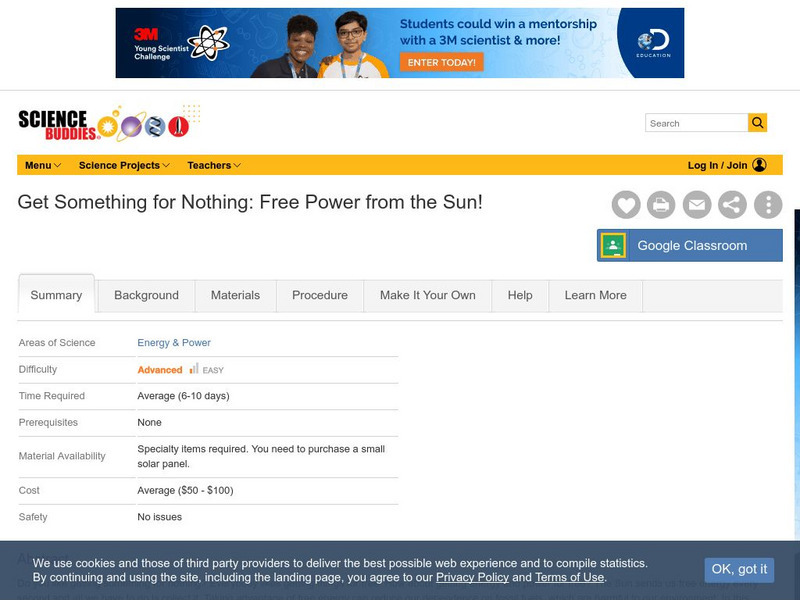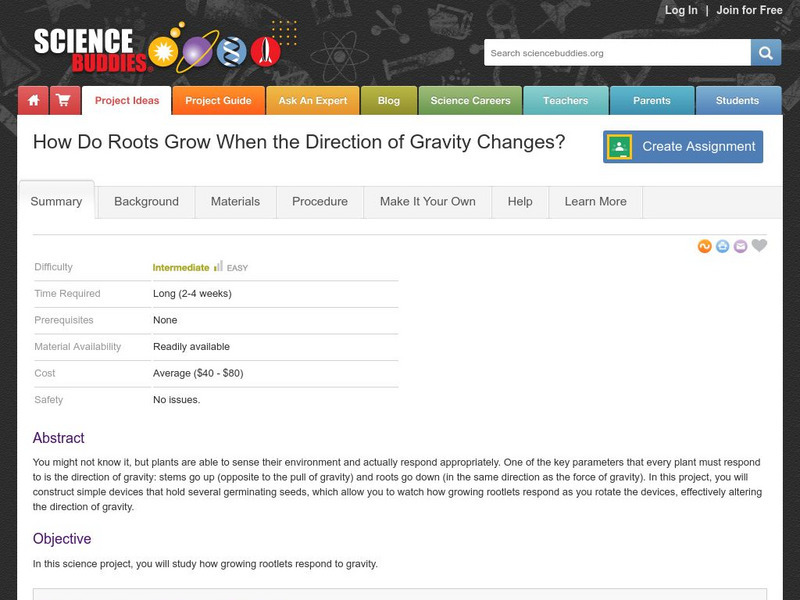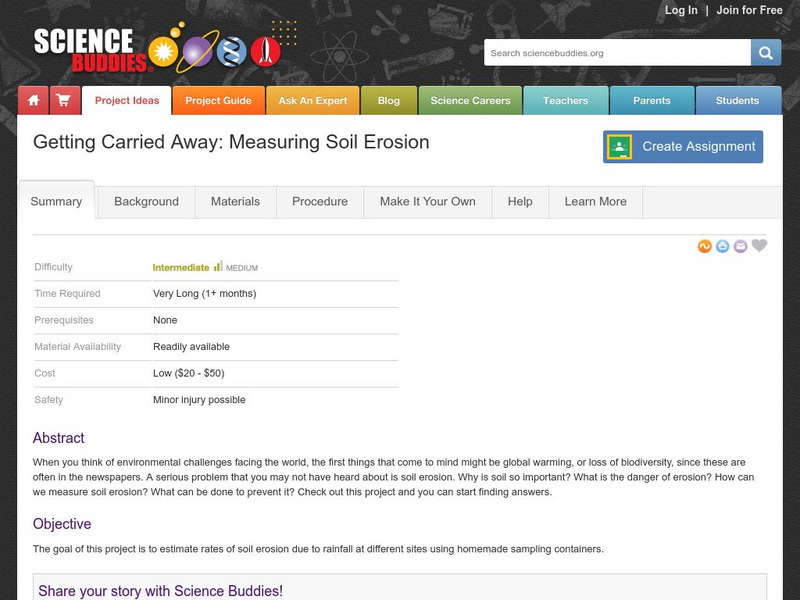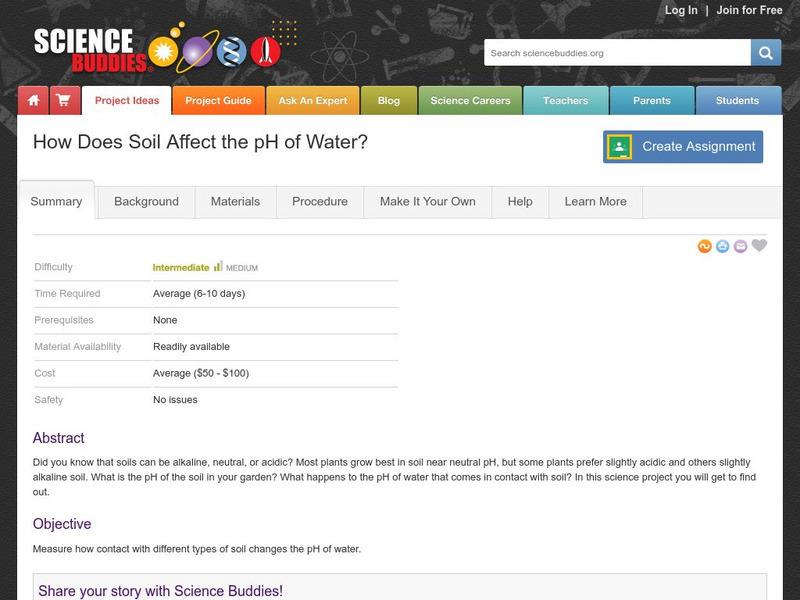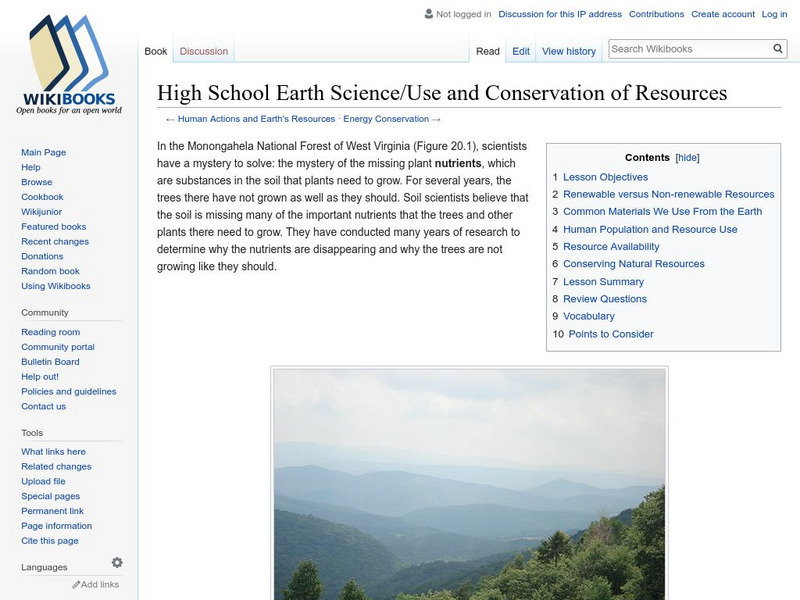Science Buddies
Science Buddies: It's Raining, It's Pouring: Chemical Analysis of Rainwater
Here is an interesting project that could be approached from several different scientific angles: Environmental Science, Weather & Atmosphere, Chemistry, or Plant Biology. You can probably think of your own variations to emphasize...
Science Buddies
Science Buddies: Home Sweet Biome: How Do Plants Grow in Different Environments?
In this science fair project you will learn about biomes and how different climatic conditions affect plant growth. This can explain why some plants and animals are similar in different areas of the country, and in other parts they are not.
Science Buddies
Science Buddies: Testing Ant Repellents
Has your house ever suffered an ant invasion? This project is an interesting way to investigate what substances are effective as ant repellents. The goal is to find substances that keep ants away, yet are safe for humans and the...
Science Buddies
Science Buddies: Solving a 'Windy' Problem
The wind is a powerful force, enough to erode whole hillsides over time. Building structures in windy environments challenge civil engineers with special safety concerns. A wall in a windy area can either shield you from the cold or fall...
Science Buddies
Science Buddies: It's Crowded in Here! A Study of Plant Population Density
Like humans, plants can be negatively affected by overcrowding. Unlike humans, plants cannot get up and move to a new environment or explore how to utilize new resources. This experiment will explore the effects of crowding (population...
Science Buddies
Science Buddies: Can the Color of Your House Reduce Your Energy Bill?
Did you know that the color of your house could save money? Do this experiment to see which colors regulate temperature best in different environments. Learn how painting the house can save money on the energy bill.
Science Buddies
Science Buddies: Antlion Pits in Open Sand or Under Leaf Cover
Antlion larvae are known for their predatory ways. In sandy areas, they dig pits to trap ants or other crawling insects that happen to stumble in. This project shows you how to create a mini-environment for antlion larvae to test their...
Science Buddies
Science Buddies: Does Temperature Affect the Rate of Butterfly Development?
This is an interesting experiment for an Investigator who is 1) curious about insect metamorphosis and 2) patient. You'll need to set up different controlled environments for the chrysalides, and then check on them regularly as you wait...
Science Buddies
Science Buddies: Get Something for Nothing: Free Power From the Sun!
Taking advantage of free energy can reduce our dependence on fossil fuels, which are harmful to our environment. In this science fair project, you will work with a solar panel, which is a collector of free energy, and investigate how...
Science Buddies
Science Buddies: Cold Room? Heat It Up With a Homemade Solar Air Heater
Humans need food, water, and warm shelter to survive. But a lot of humans depend on fossil fuels to supply gas and electricity to heat our homes. But burning fossil fuels to create energy is harmful to the environment. In this science...
Teachnology
Teachnology: Science Lesson Plans
Great lesson plans covering a wide-range of science-related subjects. A wonderful resource for wonderful teachers!
Science Buddies
Science Buddies: How Do Roots Grow When the Direction of Gravity Changes?
You might not know it, but plants are able to sense their environment and actually respond appropriately. One of the key parameters that every plant must respond to is the direction of gravity: stems go up (opposite to the pull of...
Science Buddies
Science Buddies: Bat Detector: Listen to the Secret Sounds of Bats
Sometimes bats can "whoosh" right by you, and not be seen. In this science fair project, you will be able to detect flying bats by listening in on the ultrasonic signals they produce to locate objects in their environment. The bat...
The Wonder of Science
The Wonder of Science: 3 Ls4 1: Fossil Evidence of Past Environments
Work samples, phenomena, assessment templates, and videos that directly address standard 3-LS4-1: fossil evidence of past environments.
The Wonder of Science
The Wonder of Science: K Ess3 3: Environmental Solutions
This NSTA vetted source includes resources to teach ideas on reducing the impact of humans on the environment. Included are assessment ideas, videos, examples, lesson plans, and photos of student work.
Science Buddies
Science Buddies: Getting Carried Away: Measuring Soil Erosion
When you think of environmental challenges facing the world, the first things that come to mind might be global warming, or loss of biodiversity, since these are often in the newspapers. A serious problem that you may not have heard...
Science Buddies
Science Buddies: How Does Soil Affect the P H of Water?
Did you know that soils can be alkaline, neutral, or acidic? Most plants grow best in soil near neutral pH, but some plants prefer slightly acidic and others slightly alkaline soil. What is the pH of the soil in your garden? What happens...
CK-12 Foundation
Ck 12: Earth Science: Sedimentary Rocks
[Free Registration/Login may be required to access all resource tools.] Describes how sediments weather, erode, and are deposited in a sedimentary environment.
CK-12 Foundation
Ck 12: Earth Science: Adaptation and Evolution of Populations
[Free Registration/Login may be required to access all resource tools.] Explains how natural selection favors certain traits in a population so that the organism adapts to its environment, and that changes in the genes over time cause...
CK-12 Foundation
Ck 12: Earth Science: Coastal Pollution Study Guide
This comprehensive study guide covers the main terms and concepts needed for an earth science unit on coastal pollution. Review questions are included at the bottom of the study guide.
CK-12 Foundation
Ck 12: Earth Science: Cleaning Up Groundwater Study Guide
This comprehensive study guide covers the main terms and concepts needed for an earth science unit on cleaning up groundwater. Review questions are included at the bottom of the study guide.
CK-12 Foundation
Ck 12: Life Science: 7.12 Plant Hormones
Understand how plant hormones allow plants to live in their environment.
CK-12 Foundation
Ck 12: Life Science: Mass Extinctions
[Free Registration/Login may be required to access all resource tools.] An organism goes extinct when all of the members of a species die out and no more members remain. Extinctions are part of natural selection. Species often go extinct...
Other
Wikibooks: High School Earth Science/use and Conservation of Resources
Begins with a description of a case of missing plant nutrients that have been affecting Monongahela National Forest in West Virginia. Lists some of the benefits to humans of the natural resources in such a park. Then explains the...
Other popular searches
- Environment Science
- Environmental Science
- Environmental Science Games
- Environmental Science Unit
- Ap Environmental Science
- Living Environment Science
- Environmental Science Energy
- Environmental Science Maps
- Environment Science Labs
- Land Use Environment Science
- Environment Science Dilemma
- Environment Science Graphing








